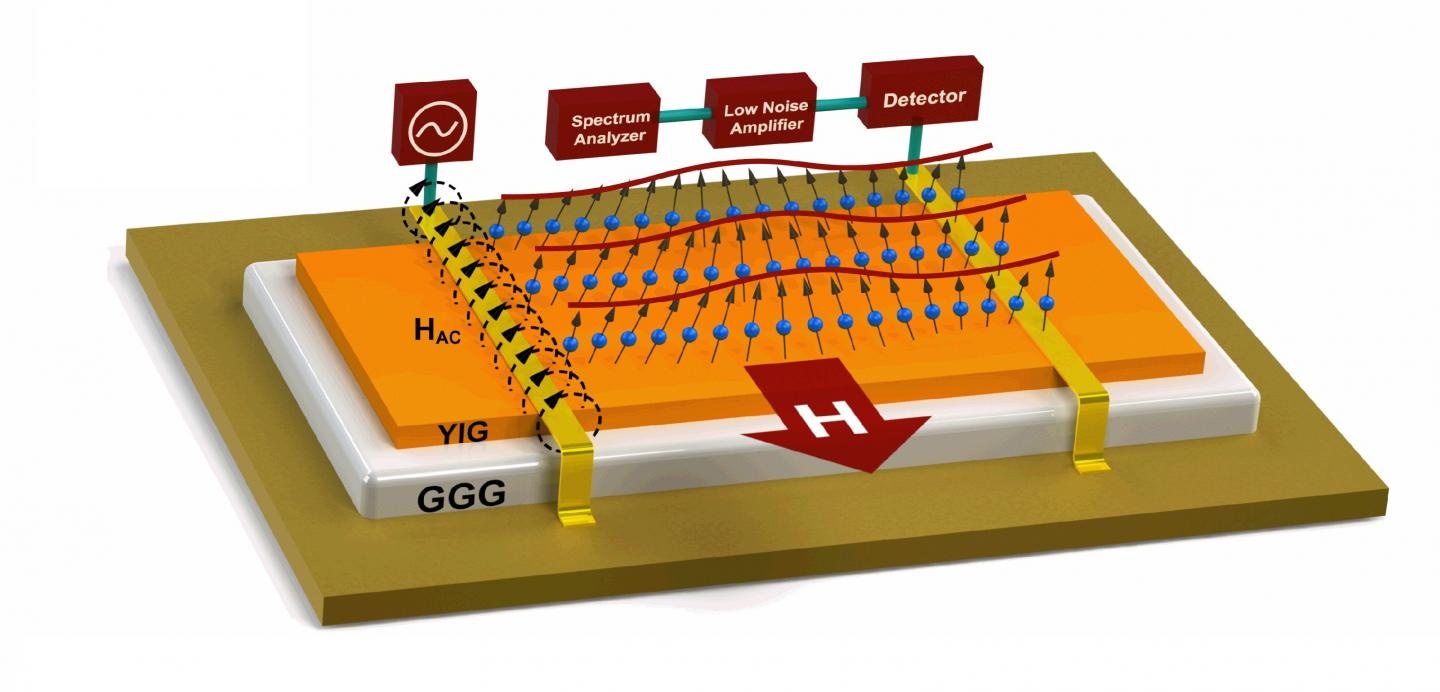By Matt Pullen, B.Sc.Mar 5 2019
Electronic devices like transistors are becoming tinier and will shortly strike the boundaries of traditional performance based on electrical currents.
 A chip that generates a magnonic current, or spin wave, between transmitting and receiving antennae. (Image credit: Balandin Lab at UC Riverside)
A chip that generates a magnonic current, or spin wave, between transmitting and receiving antennae. (Image credit: Balandin Lab at UC Riverside)
Devices developed based on magnonic currents—quasi-particles related to waves of magnetization, or spin waves, in specific magnetic materials—would revolutionize the industry; however, researchers have to better understand how to control them.
Engineers at the University of California, Riverside, have taken a significant stride toward developing practical magnonic devices by investigating, for the first time, the noise level associated with the propagation of magnon current.
Noise, or fluctuations in the flow of current, is a key metric in determining if an electronic device is ideal for practical applications. As noise interferes with the performance of a device, gaining better insights into how noisy magnons are will be useful for engineers to develop improved devices.
All prevalent electronics are based on electrical conductors, for example, metals or semiconductors. When electrons pass through these materials, they undergo scattering, which leads to heating, electrical resistance, and energy dissipation. When a semiconductor or wire conducts electric current, the unavoidable heating leads to energy loss. Smaller devices and chips including more number of transistors speed up energy loss because of heating. Devices that employ usual electronic currents have nearly reached the point where they cannot be made smaller anymore.
A new group of materials has magnetic properties that stem from spin, a type of intrinsic momentum. Individual “chunks,” or units of spin waves, are known as magnons. Although magnons are not real particles like electrons, they behave like particles and can be considered as one.
A ripple of energy known as a spin wave can travel through an electrically insulating material to conduct energy without the movement of any electrons, similar to people doing the wave in a stadium. This implies that magnons can travel without producing much heat and losing much energy.
A new realm of electronics known as magnonics tries to develop devices for information processing and storage, and also for sensory applications, using currents of magnons instead of electrons. Electron noise has been recognized for a long time, yet magnon noise has not been explored so far.
A research team under Alexander Balandin, an eminent professor of electrical and computer engineering in UC Riverside’s Marlan and Rosemary Bourns College of Engineering, developed a chip that produced a magnonic current, or spin wave, between transmitting and receiving antennae.
Experiments showed that magnons do not create much noise at low power levels. However, at high power levels, the noise turned abnormal, dominated by wide fluctuations—which are referred to as random telegraph signal noise by investigators—that would interfere with the performance of a device. The noise was visibly different from that created by electrons and finds restrictions on how to develop magnonic devices.
Magnonic devices should be preferably operating with low-power levels. One can say that the noise of magnons is discreet at low power but becomes high and discrete at a certain threshold of power. This constitutes the discreet charm of the magnonic devices. Our results also tell us possible strategies for keeping the noise level low.
Alexander Balandin, Professor of Electrical and Computer Engineering, UC Riverside
Would the discovery of abnormal noise characteristics hinder the development of magnonic devices?
“No, the goal for information processing is to go to low power,” Balandin said.
Currently, Balandin’s research team is carrying out experiments with generic components for understanding the basics. Their first experimental devices are comparatively big. They intend to study the physical mechanisms of magnon noise and test a considerably downscaled version of such devices.
The paper, “The discrete noise of magnons,” is a feature story in Applied Physics Letters, and will also be reported on the cover of an upcoming issue. Apart from Balandin, the other authors are Sergey Rumyantsev, Mykhaylo Balinskyy, Fariborz Kargar, and Alexander Khitun.
The research was supported as part of Spins and Heat in Nanoscale Electronic Systems, an Energy Frontier Research Center at UC Riverside funded by the U.S. Department of Energy, Office of Science, Basic Energy Sciences.